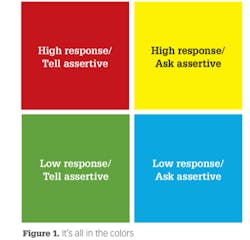How patients' social styles can impact treatment acceptance
Dr. Sam, a periodontist, had been seeing Margaret for five years for her periodontal treatment. She was missing teeth numbers 18, 19, and 20. Margaret, 74, had a partial that she wore most of the time but took out when she ate. Dr. Sam had the same conversation with her at every hygiene visit: “You are losing bone support on the lower left. It would be a good idea to get some implants in there for you. What do you think?” Margaret always said that implants cost a lot of money. After hearing the same response over and over, Dr. Sam became less enthusiastic about presenting treatment to her.
One morning, Dr. Sam’s team discussed social styles and how to approach patients differently based on what they present as important to them. This includes observable behavior, such as what a patient is wearing, their style of shoes, their gait as they walk to the treatment room, and the words they use to communicate with you.
Margaret was dressed comfortably in subtle colors and flat shoes. She had a slow gait as she took her time walking to the treatment room. The hygienist and Margaret had a lively discussion about recipes she wanted to try as she had recently purchased a new cookbook.
After Dr. Sam presented his treatment recommendation in the same way with the same result, I asked to confer with him. He believed that cost was the reason she was not interested in implants. We discussed her motivation, and he admitted these were just his feelings based on her rejections. He returned to the operatory to ask her more questions. She explained that the reasons she didn’t wear her partial when she ate is because she could not taste her food, and she constantly got food stuck under the partial. It was very uncomfortable for her.
A new approach
Dr. Sam decided to take a different approach to present his treatment. He told Margaret that she would be able to eat a wider variety of food if she had the two implants. She would be able to taste her food without having to worry about it getting stuck under the partial and causing discomfort. He explained that with implants, she would be comfortable when chewing because she would feel like she had her natural teeth. Margaret sat up and said, “You mean I’ll be able to taste my food and eat whatever I want? I don’t have much else right now and I sure enjoy good food. Why didn’t you tell me this before?”
Then she asked, “How soon can we do this?”
Identifying what is important to patients is the key to getting them back to health. The dentist is allowed to practice more interesting dentistry because case acceptance is greater. Patients are happy because their appointments are customized. When they have an exceptional patient experience, they tell others about it. Patient loyalty is created, and a great foundation is established in the dental practice. The team creates value.
4 different social styles
Social styles have been used for years to motivate patients to choose health over disease. There are four different social style “camps”—high response, low response, ask assertive, and tell assertive. A high response patient will likely stand at the front desk and have a conversation with the business assistant. Low response patients will sit in a corner and look at their phone. Patients who are ask assertive may appear hesitant when they ask for something. Tell assertive patients tell you what they need and may appear demanding.
When discussing social styles in our practice, we use colors to identify the different “camps” (figure 1). Red is a high response, tell assertive social style that values image and being recognized. They want the best. Yellow is high response, ask assertive, and they value appearance and being liked. Patients who exhibit a blue social style value comfort and security. They are low response and ask assertive. Green patients are low response and tell assertive. They love to have control of everything around them and their dental future.
If you approach a green patient (low response, tell assertive) and tell them that this is the best possible dentistry for them, they may reject your treatment plan. If you tell them this is a good investment and they will be in control of their dental future, they are more likely to listen to you.
Margaret is a low response ask assertive patient. She values comfort, and the food stuck under her partial became unbearable for her. She stopped wearing it for the very reason that she got it—to chew. Food is very important to the blue social style. They’re likely to mention new recipes they’ve tried or restaurants they frequent.
The ask assertive patients have a difficult time making decisions. These are the blues and yellows. It’s always a good idea for them to bring someone when they’re making a major decision.
As dental health providers, we’re told to propose the treatment we would provide for a loved one. “If you were my mom, this is what I would recommend for you.” If you give them more than one treatment plan, it’s highly likely they won’t do anything because they won’t be able to make a decision. You can help by saying, “I thought about a partial denture for you, but I know how much you enjoy eating steak. An implant is the better investment for you as you will not have an uncomfortable partial denture where food can get stuck.” Letting them know that you’ve considered what is important to them gives them the option.
Customizing your patients’ dental experiences by using social styles motivates them to be dentally healthy. It is all in the power of colors!
Editor's note: This article appeared in the January 2022 print edition of Dental Economics.








